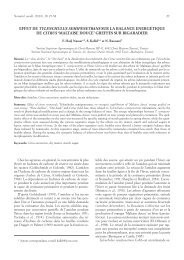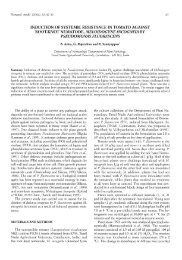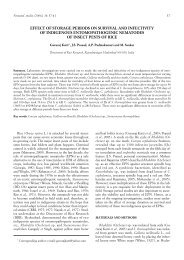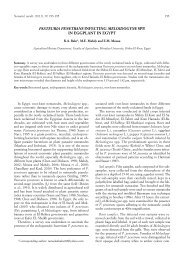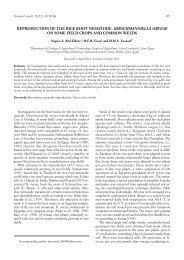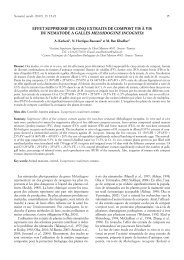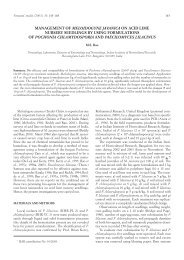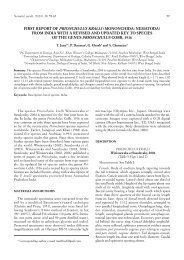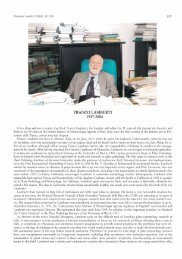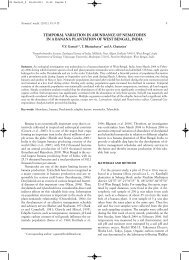host status of petunia cultivars to root-knot nematodes
host status of petunia cultivars to root-knot nematodes
host status of petunia cultivars to root-knot nematodes
- No tags were found...
Create successful ePaper yourself
Turn your PDF publications into a flip-book with our unique Google optimized e-Paper software.
Nema<strong>to</strong>l. medit. (2007), 35: 91-94 91HOST STATUS OF PETUNIA CULTIVARS TO ROOT-KNOT NEMATODESM.L. Mendes 1* , D.W. Dickson 1 , R. Schoellhorn 2 , R. Cetintas 3 and J.A. Bri<strong>to</strong> 41University <strong>of</strong> Florida, En<strong>to</strong>mology and Nema<strong>to</strong>logy Dept., Gainesville, FL 32611-0620,U.S.A.2University <strong>of</strong> Florida, Environmental Horticulture Department, Gainesville, FL 32611-0670, U.S.A.3Department <strong>of</strong> Plant Protection, University <strong>of</strong> Kahramanmaras Sutcu Imam, Kahramanmaras 46060, Turkey4Division <strong>of</strong> Plant Industry, P. O. Box 147100, Gainesville, FL 32614-7100, U.S.A.Summary. The <strong>host</strong> <strong>status</strong> <strong>of</strong> 26 <strong>cultivars</strong> <strong>of</strong> <strong>petunia</strong> (Petunia hybrida) <strong>to</strong> Meloidogyne mayaguensis and M. incognita race 4 wasevaluated under glass-house conditions. The experiment was carried out in a completely randomized design with six replicates. A<strong>to</strong>ma<strong>to</strong> cultivar was included as a susceptible <strong>host</strong> <strong>to</strong> both nema<strong>to</strong>de species. The inoculum consisted <strong>of</strong> 3,000 eggs and/or second-stagejuveniles <strong>of</strong> M. mayaguensis or M. incognita per plant. Sixty-four days after inoculation, the plants were harvested andthe numbers <strong>of</strong> galls and egg masses per <strong>root</strong> system were recorded. All <strong>petunia</strong> <strong>cultivars</strong> were highly susceptible <strong>to</strong> both nema<strong>to</strong>desand no differences were observed between the two nema<strong>to</strong>de species (P ≤ 0.05). However, fewer galls were formed by bothnema<strong>to</strong>des on cv. Supertunia Lemon Plume and by M. incognita on cv. Supertunia Lavender Pink, and fewer egg masses wereformed by M. mayaguensis on cv. Supertunia Lavender Pink and by M. incognita on cv. Supertunia Lemon Plume. The size <strong>of</strong> thegalls induced by M. mayaguensis was unusually larger than that <strong>of</strong> galls induced by M. incognita (P < 0.05). The largest galls <strong>of</strong> M.mayaguensis were observed on Easy Wave Red and Sweet Sunshine 5, whereas the largest galls <strong>of</strong> M. incognita were found on EasyWave White, Sweet Sunshine 5 and Mini Blue. The gall sizes <strong>of</strong> both nema<strong>to</strong>des were significantly larger on <strong>to</strong>ma<strong>to</strong> than on <strong>petunia</strong><strong>cultivars</strong> (P ≤ 0.05).Key words: Meloidogyne incognita, M. mayaguensis, Petunia hybrida, susceptibility.Ornamental crops represent the sixth largest agriculturalcommodity in the United States (NASS, 1999;University <strong>of</strong> Florida-IFAS Extension, 2006). Floricultureand environmental agriculture is the fastest growingsegment in this country’s agriculture and includesbedding plants, cut flowers and greens, tropical foliage,potted flowering plants, nursery crops, and turfgrasssod (Hodges and Haydu, 2000).In Florida, ornamental crop production is a rapidlyexpanding industry and the state is the second rankedproducer <strong>of</strong> ornamental plants in the United States (University<strong>of</strong> Florida-IFAS Extension, 2006). The grosswholesale value for U.S.-grown floriculture and nurserycrops in 2001 reached $13.3 billion, <strong>of</strong> which $1.6 billionwas produced in Florida alone (Hodges and Haydu,2003).Petunia [Petunia hybrida (Hook.) Vilm.] is one <strong>of</strong> themost popular bedding plants. Offering a broad variety<strong>of</strong> flower colors, from white through purple <strong>to</strong> two-color<strong>cultivars</strong>, they are used in landscaping for filling borders.The fact that they are so widely grown has encouragedbreeders <strong>to</strong> improve them, resulting in the release<strong>of</strong> new <strong>cultivars</strong> every year. However, the appearance <strong>of</strong>these colorful annual plants in the landscape can be diminishedby pests and diseases, including plant-parasiticnema<strong>to</strong>des and especially <strong>root</strong>-<strong>knot</strong> nema<strong>to</strong>des,Meloidogyne spp. So far, there is relatively little informationregarding <strong>to</strong> the response <strong>of</strong> <strong>petunia</strong> <strong>cultivars</strong> <strong>to</strong>*Corresponding author: e-mail: mlmendes@ufl.eduplant-parasitic nema<strong>to</strong>des. Root-<strong>knot</strong> nema<strong>to</strong>des are themost widespread and destructive <strong>of</strong> plant nema<strong>to</strong>des(Walker et al., 1994; Dunn, 1997; Bri<strong>to</strong> et al., 2004a).Some <strong>petunia</strong> <strong>cultivars</strong> have been reported as <strong>host</strong>sfor different <strong>root</strong>-<strong>knot</strong> nema<strong>to</strong>de species. G<strong>of</strong>f (1936)was the first scientist <strong>to</strong> investigate the reaction <strong>of</strong> annualbedding plants, including a <strong>petunia</strong> cultivar, <strong>to</strong> <strong>root</strong><strong>knot</strong>nema<strong>to</strong>des; however, the plant <strong>cultivars</strong> and nema<strong>to</strong>despecies were not identified. According <strong>to</strong> McSorleyand Frederick (1994), <strong>petunia</strong> cv. Dwarf Bedding wassusceptible <strong>to</strong> M. javanica (Treub) Chitw. and M. arenaria(Neal) Chitw. race 1, and <strong>petunia</strong> cv. Color ParadeHybrid Mix was susceptible <strong>to</strong> M. incognita (K<strong>of</strong>oid etWhite) Chitw. race 1. McSorley (1994) also found <strong>petunia</strong>cv. Fire Chief susceptible <strong>to</strong> M. arenaria race 1, withsevere galling. In a microplot study under field conditionsin India, Khan et al. (2005) state that M. incognita(race not specified) had led <strong>to</strong> a 37% decrease in flowerproduction in <strong>petunia</strong> cv. Silver Spring.In Florida, M. arenaria, M. incognita and M. javanicaare the most common <strong>root</strong>-<strong>knot</strong> nema<strong>to</strong>des (Dunn,1997; Inserra et al., 2003). In addition <strong>to</strong> these species,M. mayaguensis Rhamma et Hirschman was discoveredin 2001 (Bri<strong>to</strong> et al., 2003; Inserra et al., 2003), representinga new challenge <strong>to</strong> growers. Since then, M.mayaguensis has been found in 10 counties infectingmany important agronomic crops, such as soybean andguava, vegetables, ornamentals grown in nurseries andgreenhouses, and many other plant species, includingweeds, belonging <strong>to</strong> several botanical families (Bri<strong>to</strong> etal., 2003; Bri<strong>to</strong> et al., 2004a; Levin et al., 2004; Cetintas
92et al., 2005; Mendes et al., 2005). This nema<strong>to</strong>de is <strong>of</strong>particular importance due <strong>to</strong> its ability <strong>to</strong> reproduce on<strong>root</strong>-<strong>knot</strong> nema<strong>to</strong>de resistant <strong>cultivars</strong> <strong>of</strong> crops such aspepper and <strong>to</strong>ma<strong>to</strong> (Bri<strong>to</strong> et al., 2004b).While P. hybrida is already a known <strong>host</strong> <strong>of</strong> the commonspecies <strong>of</strong> <strong>root</strong>-<strong>knot</strong> nema<strong>to</strong>des, the <strong>host</strong> <strong>status</strong> <strong>of</strong>new <strong>cultivars</strong> had not yet been evaluated. Likewise, informationabout the reaction <strong>of</strong> <strong>petunia</strong> <strong>to</strong> M.mayaguensis is also lacking. Similarly, information aboutsusceptibility <strong>of</strong> <strong>petunia</strong> <strong>to</strong> race 4 <strong>of</strong> M. incognita is alsounknown. Therefore, this study was designed <strong>to</strong> evaluatethe reaction <strong>of</strong> new <strong>petunia</strong> <strong>cultivars</strong> <strong>to</strong> these particular<strong>root</strong>-<strong>knot</strong> nema<strong>to</strong>des.MATERIALS AND METHODSThe responses <strong>of</strong> twenty-six <strong>cultivars</strong> <strong>of</strong> <strong>petunia</strong> (P.hybrida) <strong>to</strong> M. mayaguensis and M. incognita race 4 werechecked under glass-house conditions. The experimentwas carried out in a completely randomized design withsix replicates. Toma<strong>to</strong> (Lycopersicon esculentum Mill.)cv. Rutgers was included as a susceptible <strong>host</strong> <strong>to</strong> bothnema<strong>to</strong>de species.The <strong>petunia</strong> seedlings were provided by the EnvironmentalHorticulture Department, University <strong>of</strong> Florida,Gainesville, FL. Thirty-two-day-old seedlings were transplantedsingly <strong>to</strong> 10 cm diameter clay pots containing amixture (1:3) <strong>of</strong> steam-pasteurized sand soil and pottingsoil (Fafard No. 3 – Conrad Fafard, Inc., Agawam, MA,USA). Ten days after transplanting, each plant was inoculatedwith 3,000 eggs and/or second-stage juveniles <strong>of</strong> M.mayaguensis or M. incognita. Nema<strong>to</strong>de inocula for bothspecies were obtained from single egg mass populationsmaintained on <strong>to</strong>ma<strong>to</strong> cv. Rutgers in a glass-house. Theeggs were extracted from the <strong>root</strong> systems in 0.25% sodiumhypochlorite solution using the technique <strong>of</strong> Husseyand Barker (1973) modified by Bonetti and Ferraz (1981).Inoculated plants were maintained under glass-houseconditions at an average temperature <strong>of</strong> 27 ºC. The ambienttemperature ranged from 23 ºC <strong>to</strong> 31ºC. Plantswere watered daily and fertilized twice a week withNPK Peter’s fertilizer (20-20-20) according <strong>to</strong> the manufacturer’sinstructions. At 64 days after inoculation theplants were harvested; the <strong>root</strong> systems were removedfrom the pots, carefully washed <strong>to</strong> remove the soil, andrated for galls and egg masses per <strong>root</strong> system using the0 - 5 scale proposed by Taylor and Sasser (1978). Becausevisual observation showed that gall sizes variedconsiderably, one plant <strong>of</strong> eight selected <strong>cultivars</strong> (TableII) and one <strong>of</strong> <strong>to</strong>ma<strong>to</strong> infected either by M. mayaguensisor M. incognita were chosen <strong>to</strong> determine the diameters<strong>of</strong> the galls. Five galls on each plant were measured.The analysis <strong>of</strong> variance (ANOVA) <strong>of</strong> the data wasperformed using SAS s<strong>of</strong>tware (SAS Institute, Care,NC) and mean separation (P ≤ 0.05) for <strong>root</strong> gall andegg mass indices was with Waller-Duncan’s multiplerange.RESULTS AND DISCUSSIONAll <strong>petunia</strong> <strong>cultivars</strong> evaluated in this study werehighly susceptible <strong>to</strong> M. mayaguensis and M. incognitarace 4. The great majority <strong>of</strong> the <strong>petunia</strong> genotypes hadmore than 100 galls and egg masses per <strong>root</strong> system inducedby both nema<strong>to</strong>des, and the infestation <strong>of</strong> <strong>petunia</strong><strong>cultivars</strong> was similar <strong>to</strong> that <strong>of</strong> <strong>to</strong>ma<strong>to</strong> cv. Rutgersused as control (Table I). The gall index ranged from3.2 <strong>to</strong> 5.0 for M. mayaguensis and 4.5 <strong>to</strong> 5.0 for M.incognita race 4, whereas the egg mass index rangedfrom 4.0 <strong>to</strong> 5.0 for M. mayaguensis and from 4.3 <strong>to</strong> 5.0for M. incognita, respectively. The <strong>cultivars</strong> SupertuniaLemon Plume, Supertunia Lavender Pink and SurfiniaRed Petunia exhibited lower gall and/or egg mass indicesthan other genotypes (Table I). However, the cultivarSupertunia Lemon Plume had significantly smallergall indices caused by both nema<strong>to</strong>des and SupertuniaLavender Pink a lower gall index induced by M. incognita.The size <strong>of</strong> the galls induced by M. mayaguensisboth on <strong>petunia</strong> <strong>cultivars</strong> and <strong>to</strong>ma<strong>to</strong> was usually largerthan that <strong>of</strong> the galls induced by M. incognita. The galldiameter <strong>of</strong> M. mayaguensis ranged from 0.10 cm <strong>to</strong>0.60 cm on <strong>petunia</strong> and from 0.10 cm <strong>to</strong> 1.1 cm on<strong>to</strong>ma<strong>to</strong>. For M. incognita the gall size varied from 0.05cm <strong>to</strong> 0.30 cm on <strong>petunia</strong> and from 0.05 cm <strong>to</strong> 0.60 cmon <strong>to</strong>ma<strong>to</strong>. The difference in mean gall size (P < 0.05)between M. mayaguensis (0.48 cm) and M. incognita(0.20 cm) was significant. The largest galls <strong>of</strong> M.mayaguensis were observed on Easy Wave Red andSweet Sunshine 5, whereas for M. incognita they werefound on Easy Wave White, Sweet Sunshine 5 and MiniBlue. The gall sizes <strong>of</strong> both nema<strong>to</strong>des were larger on<strong>to</strong>ma<strong>to</strong> than those on <strong>petunia</strong> <strong>cultivars</strong> and the differencewas significant (P ≤ 0.05) (Table II).Many bedding plants have been tested for their responses<strong>to</strong> <strong>root</strong>-<strong>knot</strong> nema<strong>to</strong>des (McSorley, 1994; Wangand McSorley, 2005). However, prior <strong>to</strong> our test, just afew <strong>petunia</strong> <strong>cultivars</strong> had been evaluated against M. javanica,M. incognita and M. arenaria (McSorley, 1994;McSorley and Frederick, 1994; Khan et al., 2005) andresistance was not found. Different <strong>cultivars</strong> <strong>of</strong> manyspecies <strong>of</strong> annual plants react differently <strong>to</strong> <strong>root</strong>-<strong>knot</strong>nema<strong>to</strong>des (Dunn, 1997). A difference in reaction <strong>of</strong>two white dill <strong>cultivars</strong> <strong>to</strong> M. incognita re-emphasizesthat variability in susceptibility within a plant speciesdoes exist (Wang and McSorley, 2005). Such differenceswere not observed in <strong>petunia</strong> in this study. No <strong>petunia</strong>cultivar had previously been tested against M.mayaguensis. Our findings showed that many P. hybridagenotypes are highly susceptible <strong>to</strong> this <strong>root</strong>-<strong>knot</strong> nema<strong>to</strong>despecies. This is not surprising since M. mayaguensishas a wide <strong>host</strong> range, including plants in several botanicalfamilies (Bri<strong>to</strong> et al., 2007).Meloidogyne mayaguensis and M. incognita are importantpathogens and probably the most damaging nema<strong>to</strong>des<strong>to</strong> <strong>petunia</strong>s and many other ornamental plants.The suitability <strong>of</strong> different <strong>cultivars</strong> as <strong>host</strong>s must be
Mendes et al. 93Table I. Host <strong>status</strong> <strong>of</strong> 26 <strong>petunia</strong> <strong>cultivars</strong>, compared <strong>to</strong> <strong>to</strong>ma<strong>to</strong> cv. Rutgers, <strong>to</strong> Meloidogyne mayaguensis and M. incognita race 4in a glass-house trial.Cultivar Gall indexGall 1 index 1 Egg mass index Egg mass 1 index 1M. mayaguensis M. incognita race 4 M. mayaguensis M. incognita race 4Easy Wave Red 2 5.0 a 5.0 a 5.0 a 5.0 a 5.0 a 5.0 a 5.0 a 5.0 aEasy Wave Rose Down 5.0 a 5.0 a 5.0 a 5.0 a 5.0 a 5.0 a 5.0 a 5.0 aEasy Wave White 2 5.0 a 5.0 a 5.0 a 5.0 a 5.0 a 5.0 a 5.0 a 5.0 aMadness Midnight 288 2 5.0 a 5.0 a 4.6 a 4.6 a 5.0 a 5.0 a 4.6 ab4.6 abMilliflora Prostrate (Whisper Purple) 2 5.0 a 5.0 a 5.0 a 5.0 a 5.0 a 5.0 a 5.0 a 5.0 aMiniflora Prostrate (Whisper White) 5.0 a 5.0 a 5.0 a 5.0 a 5.0 a 5.0 a 5.0 a 5.0 aPetunia Mini Blue 2 5.0 a 5.0 a 5.0 a 5.0 a 5.0 a 5.0 a 5.0 a 5.0 aPetunia Suncatcher (Lavender Impera<strong>to</strong>r) 5.0 a 5.0 a 5.0 a 5.0 a 5.0 a 5.0 a 5.0 a 5.0 aPetunia Pink Vein (Florida) 5.0 a 5.0 a 5.0 a 5.0 a 5.0 a 5.0 a 5.0 a 5.0 aSuncatcher Dark Lavender 5.0 a 5.0 a 5.0 a 5.0 a 5.0 a 5.0 a 5.0 a 5.0 aSuncatcher Saphire 5.0 a 5.0 a 5.0 a 5.0 a 5.0 a 5.0 a 5.0 a 5.0 aSupertunia Blushing Princess 5.0 a 5.0 a 5.0 a 5.0 a 5.0 a 5.0 a 5.0 a 5.0 aSupertunia Lavender Morn 5.0 a 5.0 a 5.0 a 5.0 a 5.0 a 5.0 a 5.0 a 5.0 aSupertunia Lavender Pink 5.0 a 5.0 a 4.0 b 4.0 b 4.5 b 4.5 b 5.0 a 5.0 aSupertunia Lemon Plurne 3.2 b 3.2 b 4.2 b 4.2 b 5.0 a 5.0 a 4.3 b 4.3 bSupertunia Mini (Blue Veined) 5.0 a 5.0 a 5.0 a 5.0 a 5.0 a 5.0 a 5.0 a 5.0 aSupertunia Mini (Bright Pink) 5.0 a 5.0 a 5.0 a 5.0 a 5.0 a 5.0 a 5.0 a 5.0 aSupertunia Mini (Pastel Pink) 5.0 a 5.0 a 5.0 a 5.0 a 5.0 a 5.0 a 5.0 a 5.0 aSupertunia Mini Purple 5.0 a 5.0 a 5.0 a 5.0 a 5.0 a 5.0 a 5.0 a 5.0 aSupertunia Mystic Pink 5.0 a 5.0 a 5.0 a 5.0 a 5.0 a 5.0 a 5.0 a 5.0 aSupertunia Red 5.0 a 5.0 a 5.0 a 5.0 a 5.0 a 5.0 a 5.0 a 5.0 aSurfinia Baby Compact (Amethyst Petunia) 5.0 a 5.0 a 5.0 a 5.0 a 5.0 a 5.0 a 5.0 a 5.0 aSurfinia Red Petunia 4.8 a 4.8 a 4.8 a 4.8 a 5.0 a 5.0 a 4.8 a 4.8 aSurfinia Sugar Plum 2 5.0 a 5.0 a 5.0 a 5.0 a 5.0 a 5.0 a 5.0 a 5.0 aSweet Sunshine 5 2 5.0 a 5.0 a 5.0 a 5.0 a 5.0 a 5.0 a 5.0 a 5.0 aTidal Wave Silver 2 5.0 a 5.0 a 5.0 a 5.0 a 5.0 a 5.0 a 5.0 a 5.0 aToma<strong>to</strong> ‘Rutgers’ (control) 5.0 a 5.0 a 5.0 a 5.0 a 5.0 a 5.0 a 5.0 a 5.0 aData are means <strong>of</strong> six replications. Means within a column followed by a common letter are not different according <strong>to</strong> Waller-Duncan’s multiple-range test (P ≤ 0.05).1Gall Index/ Egg mass Index: 0 = no galls or egg masses; 1 = 1 - 2 galls or egg masses; 2 = 3 - 10 galls or egg masses; 3 = 11 - 30; 4= 31 - 100 galls or egg masses; 5 = more than 100 galls or egg masses (Taylor and Sasser, 1978).2 Cultivars selected for gall size measurement.Table II. Gall size induced by Meloidogyne mayaguensis andM. incognita race 4 on eight <strong>petunia</strong> <strong>cultivars</strong> compared <strong>to</strong> tha<strong>to</strong>n <strong>to</strong>ma<strong>to</strong> cv. Rutgers in a glass-house trial.CultivarGall diameter (cm)________________________________M. mayaguensis M. incognita race 4Easy Wave Red 0.53 b0.53 b 0.20 bc 0.20 bcEasy Wave White 0.49 bc 0.49 bc 0.22 b0.22 bMadness Midnight 288 0.49 bc 0.49 bc 0.08 c0.08 cMilliflora Prostrate(Whisper Purple) 0.29 c0.29 c 0.20 bc 0.20 bcPetunia Mini Blue 0.37 bc 0.37 bc 0.23 b0.23 bSurfinia Sugar Plum 0.47 bc 0.47 bc 0.09 bc 0.09 bcSweet Sunshine 5 0.53 b0.53 b 0.22 b0.22 bTidal Wave Silver 0.43 bc 0.43 bc 0.19 bc 0.19 bcToma<strong>to</strong> ‘Rutgers’ (control) 0.76 a0.76 a 0.40 a0.40 aData are means <strong>of</strong> five replications. Means within a columnfollowed by a common letter are not different according <strong>to</strong>Waller-Duncan’s multiple-range test (P ≤ 0.05).recognized <strong>to</strong> avoid damage. If susceptible <strong>cultivars</strong> aresuccessively planted in the same area it can led <strong>to</strong> an increase<strong>of</strong> nema<strong>to</strong>de population <strong>to</strong> levels that will affectplant growth, flower production and flower quality.Potted plants and transplants should be free <strong>of</strong> plantparasiticnema<strong>to</strong>des. Thus, it is important <strong>to</strong> know thenema<strong>to</strong>de species, and races if possible, that are presentin a location before any landscape planting begins. If<strong>root</strong>-<strong>knot</strong> nema<strong>to</strong>de is found, bedding plants othersthan <strong>petunia</strong> should be considered for inclusion.ACKNOLEDGMENTSThe authors thank Dr. Ramandeep Kaur and JoeyOrajay for critically reviewing the manuscript and Mr.Luis Collazo for technical assistance.This research was supported by the TSTAR grantUSDA-CSREES 2005-34135-15895.
94LITERATURE CITEDBonetti J.I.S. and Ferraz S., 1981. Modificações do mé<strong>to</strong>do deHussey & Barker para a extração de ovos de Meloidogyneexigua, em raízes de cafeeiro K. Fi<strong>to</strong>pa<strong>to</strong>logia Brasileira, 3:553.Bri<strong>to</strong> J.A., Stanley J.D., Mendes M.L. and Dickson D.W.,2003. Host <strong>status</strong> <strong>of</strong> selected plant species <strong>to</strong> Meloidogynemayaguensis from Florida. Nematropica, 33: 99.Bri<strong>to</strong> J.A., Powers T.O., Mullin P.G., Inserra R.N. and DicksonD.W., 2003. Morphological and molecular characterization<strong>of</strong> Meloidogyne mayaguensis from Florida. Journal <strong>of</strong>Nema<strong>to</strong>logy, 35: 327-328.Bri<strong>to</strong> J.A., Stanley J.D., Cetintas R., Powers T.O., InserraR.N., McAvoy E.J., Mendes M.L., Crow W.T. and DicksonD.W., 2004a. Identification and <strong>host</strong> preference <strong>of</strong>Meloidogyne mayaguensis, and other <strong>root</strong>-<strong>knot</strong> nema<strong>to</strong>desfrom Florida, and their susceptibility <strong>to</strong> Pasteuriapenetrans. Journal <strong>of</strong> Nema<strong>to</strong>logy, 36: 308-309.Bri<strong>to</strong> J.A, Stanley J.D., Cetintas R., Di Vi<strong>to</strong> M., Thies J.A. andDickson D.W., 2004b. Reproduction <strong>of</strong> Meloidogynemayaguensis from Florida on <strong>root</strong>-<strong>knot</strong> resistant <strong>to</strong>ma<strong>to</strong>and pepper. Journal <strong>of</strong> Nema<strong>to</strong>logy, 36: 308.Bri<strong>to</strong> J.A., Stanley J.D., Mendes M.L., Cetintas R. and DicksonD.W., 2007. Host range studies <strong>of</strong> Meloidogynemayaguensis from Florida. Nematropica, 37(1): in press.Cetintas R., Bri<strong>to</strong> J.A. and Dickson D.W., 2005. Pathogenicity<strong>of</strong> four isolates <strong>of</strong> Meloidogyne mayaguensis from Florida<strong>to</strong> selected soybean <strong>cultivars</strong>. Nematropica, 35: 66.Dunn A.R., 1997. Nema<strong>to</strong>de management for ornamentals in thelandscape. Nema<strong>to</strong>logy Pointer No. 42 (SS-ENY-23). FloridaCooperative Extension Service, University <strong>of</strong> Florida, Institute<strong>of</strong> Food and Agricultural Services, Gainesville,U.S.A., 11 pp.G<strong>of</strong>f C.C., 1936. Relative susceptibility <strong>of</strong> some annual ornamentals<strong>to</strong> <strong>root</strong>-<strong>knot</strong> nema<strong>to</strong>des. Bulletin 291, University <strong>of</strong>Florida Agricultural Experiment Station, Gainesville,U.S.A., 1 p.Hodges A.W. and Haydu J.J., 2000. A decade <strong>of</strong> change inFlorida’s ornamental plant nursery industry, 1989 <strong>to</strong> 1999.http://hortbusiness.ifas.ufl.edu/EIR00-3.pdf (Accessed on6 February 2007).Hodges A.W. and Haydu J.J., 2003. Commodity outlook 2003:U.S. and Florida ornamental plant markets. University <strong>of</strong>Florida - Extension. Institute <strong>of</strong> Food and Agricultural Sciences,EDIS document FE374. http://edis.ifas.ufl.edu. (Accessedon 13 March 2007).Hussey R.S. and Barker K.R., 1973. A comparison <strong>of</strong> methodsfor collecting inocula <strong>of</strong> Meloidogyne spp. including a newtechnique. Plant Disease Reporter, 57: 1025-1028.Inserra R.N., Bri<strong>to</strong> J.A. and Mendes M.L., 2003. Morphologicalanalysis for identification <strong>of</strong> Meloidogyne mayaguensisin Florida and its associated problems. Nematropica, 33:106-107.Khan M.R., Khan S.M. and Mohide F., 2005. Root-<strong>knot</strong> nema<strong>to</strong>deproblem <strong>of</strong> some winter ornamental plants and itsbiomanagement. Journal <strong>of</strong> Nema<strong>to</strong>logy, 37: 198-206.Levin R., Bri<strong>to</strong> J.A., Crow W.T. and Schoellhorn R.K., 2004.Susceptibility <strong>of</strong> several perennial ornamentals <strong>to</strong> fourspecies <strong>of</strong> <strong>root</strong>-<strong>knot</strong> nema<strong>to</strong>des. Journal <strong>of</strong> Nema<strong>to</strong>logy, 36:330 (abstract).McSorley R., 1994. Susceptibility <strong>of</strong> common bedding plants<strong>to</strong> <strong>root</strong>-<strong>knot</strong> nema<strong>to</strong>des. Proceedings <strong>of</strong> the Florida StateHorticultural Society, 107: 430-432.McSorley R. and Frederick J.J., 1994. Response <strong>of</strong> some commonannual bedding plants <strong>to</strong> three species <strong>of</strong> Meloidogyne.Journal <strong>of</strong> Nema<strong>to</strong>logy, 26(4S): 773-777.Mendes M.L., Dickson D.W., Schoellhorn R.K., Cetintas R.and Bri<strong>to</strong> J.A., 2005. Host <strong>status</strong> <strong>of</strong> <strong>petunia</strong> <strong>cultivars</strong> <strong>to</strong><strong>root</strong>-<strong>knot</strong> nema<strong>to</strong>des. Journal <strong>of</strong> Nema<strong>to</strong>logy, 37: 383-384.NASS- National Agricultural Statistics Service, 1999. Census<strong>of</strong> Agriculture, 1997. United States Department <strong>of</strong> Agriculture,Washin<strong>to</strong>n, DC, U.S.A.Taylor A.L. and Sasser J.N., 1978. Biology, identification andcontrol <strong>of</strong> <strong>root</strong>-<strong>knot</strong> nema<strong>to</strong>des (Meloidogyne spp.). NorthCarolina State University Graphics, Raleigh, U.S.A., 111pp.University <strong>of</strong> Florida-IFAS Extension, 2006. Small Farms –Alternative Enterprises. Solutions for your life. http://smallfarms.ifas.ufl.edu/crops/ornamentals/overview.html(Accessed on 13 March 2007).Walker J.T., Melin J.B. and Davis J., 1994. Sensitivity <strong>of</strong> beddingplants <strong>to</strong> Southern <strong>root</strong>-<strong>knot</strong> nema<strong>to</strong>de, Meloidogyneincognita race 3. Journal <strong>of</strong> Nema<strong>to</strong>logy, 26(4S): 778-781.Wang K.-H. and McSorley R., 2005. Host <strong>status</strong> <strong>of</strong> several cutflower crops <strong>to</strong> <strong>root</strong>-<strong>knot</strong> nema<strong>to</strong>de, Meloidogyne incognita.Nematropica, 35: 45-52.Accepted for publication on 23 April 2007.





